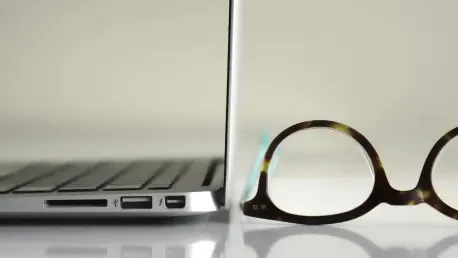The rapid pivot to remote work, accelerated by the global health crisis a few years ago, has fundamentally altered the professional landscape for millions of American employees, reshaping not just where they work but how they manage their health and appearance in a virtual world. As countless individuals traded traditional office spaces for home setups, the reliance on digital devices for communication and productivity surged, bringing with it a host of new challenges related to eye health and visual comfort. This shift has placed eyewear at the forefront of workplace necessities, with workers now seeking solutions to combat the effects of prolonged screen time while maintaining a polished look during video calls. The demand for specialized glasses has grown, driven by concerns over digital eye strain, the impact of blue light, and the need to adapt to varied home office environments. This transformation highlights a broader reevaluation of how essential tools like eyewear must evolve to meet the unique demands of remote work, reflecting changes in both technology use and personal priorities.
Addressing the Surge in Digital Eye Strain
The transition to remote work has led to a noticeable increase in digital eye strain, a condition often termed computer vision syndrome, affecting a significant portion of the workforce. With many employees now tethered to screens for 8 to 12 hours daily—whether on laptops, tablets, or smartphones—symptoms like dry eyes, blurred vision, and persistent headaches have become all too common. Unlike conventional office environments where varied tasks might naturally break up screen time, home-based work often involves uninterrupted digital focus, amplifying discomfort. Healthcare providers have observed a marked rise in vision-related complaints, underscoring the critical need for protective strategies. Specialized eyewear has emerged as a key solution, offering relief through features tailored to mitigate the effects of extended exposure. This growing awareness signals a shift in how workers prioritize eye health, recognizing that without intervention, the risk of long-term damage looms large in the digital era.
Another pressing issue tied to digital eye strain is the exposure to blue light emitted from screens, which has raised concerns about its potential to cause visual fatigue and disrupt sleep cycles. Although scientific consensus on the full extent of blue light’s impact is still forming, many remote workers have reported tangible benefits from using glasses designed to filter these wavelengths. Such eyewear often incorporates anti-reflective coatings to reduce glare and may include slight magnification to ease the burden of close-up tasks. These features are particularly valuable for those whose daily routines are dominated by digital interfaces, providing a buffer against the constant strain of near-field focus. Importantly, prescriptions for computer use differ from standard distance vision corrections, emphasizing the need for tailored solutions. This trend reflects a broader understanding that addressing blue light exposure through specialized glasses is not just a convenience but a necessary adaptation for maintaining productivity and well-being in remote settings.
Balancing Functionality with Professional Style
Remote work has redefined eyewear as more than a mere vision aid, transforming it into a critical element of professional identity and personal style in the virtual workspace. With video conferencing now a cornerstone of business communication, employees are increasingly mindful of their on-screen appearance, seeking frames that convey professionalism while supporting long hours of computer use. Glasses have become a subtle yet powerful tool for personal branding during virtual meetings, where first impressions are often digital. The demand for stylish yet functional designs has surged, as workers aim to project competence and confidence through their choice of eyewear. This dual role underscores a cultural shift, where practical tools must also align with aesthetic preferences, catering to the unique visibility demands of remote interactions and highlighting how appearance remains a key factor even outside physical office walls.
Adding to the complexity of eyewear needs is the variability of home office environments, particularly in terms of lighting conditions that differ vastly from controlled corporate settings. Glare from natural light streaming through windows or harsh artificial lighting can significantly impede screen visibility, creating distractions during crucial video calls or focused work sessions. Anti-reflective coatings on glasses have become a sought-after feature, helping to minimize these disruptions and ensure clear vision under diverse conditions. This adaptation is essential for maintaining focus and reducing eye fatigue in spaces not originally designed for professional use. As remote workers navigate these environmental challenges, the integration of technical features into eyewear design proves indispensable, bridging the gap between functionality and the practical realities of working from home. It reveals how deeply the remote work model influences even the smallest details of daily professional life.
Integrating Eyewear into Workplace Wellness
Progressive employers are beginning to view eye health as a vital component of overall employee well-being, especially in the context of remote work where direct oversight is limited. Recognizing that prolonged screen time poses significant risks, some companies have introduced stipends or reimbursement programs for computer glasses, seeing them as an investment in productivity and a means to reduce potential healthcare expenses. These initiatives often extend beyond standard vision insurance, covering specialized eyewear that offers comfort even if not classified as medically essential. Such policies demonstrate an evolving corporate mindset, where supporting visual health is prioritized as a strategic benefit rather than a mere perk. This approach not only aids employees in managing the physical toll of remote work but also fosters a culture of care, acknowledging the unique strains of digital-heavy roles in today’s professional environment.
Beyond financial support, workplace wellness programs are increasingly focused on educating remote employees about proactive eye care practices to complement the use of specialized eyewear. Strategies such as the 20-20-20 rule—looking at an object 20 feet away for 20 seconds every 20 minutes—are promoted alongside tips for optimal monitor positioning and adequate lighting setups. These educational efforts aim to reduce the incidence of digital eye strain by encouraging behavioral adjustments that work in tandem with protective glasses. Additionally, there’s growing discussion around potential tax benefits, with computer glasses possibly qualifying as a deductible business expense under certain conditions. This comprehensive focus on eye health reflects a deeper understanding among employers that sustaining a productive remote workforce requires addressing both the tools and the habits that shape daily work life, ensuring employees are equipped to thrive in less conventional settings.
Future Horizons for Eyewear in Remote Work
Looking ahead, technological innovation stands poised to revolutionize eyewear solutions for remote workers, addressing both current challenges and anticipating future needs in the digital workspace. Advances in smart glasses are particularly promising, with potential features like dynamic blue light filtering that adjusts based on time of day or automatic magnification shifts for varied tasks. Such developments aim to offer a personalized approach to visual comfort, adapting in real-time to the user’s environment and activities. The integration of augmented reality capabilities could further transform how digital content is accessed, reducing physical strain by projecting information at more natural viewing angles. These cutting-edge solutions signal a move toward eyewear that not only protects but actively enhances the remote work experience, aligning with the broader trend of technology integration in everyday professional tools.
Equally significant is the progress in accessibility and precision for obtaining suitable eyewear, a critical factor for remote workers who may face barriers to in-person optometry services. Remote eye exams and advanced measurement tools have streamlined the process of securing accurate prescriptions, allowing for properly fitted glasses without the need for physical visits. This convenience is invaluable for those in less accessible locations or with demanding schedules, ensuring that eye health remains a priority regardless of circumstance. As these innovations continue to unfold, they promise to make specialized eyewear more attainable and effective, catering to the diverse needs of a dispersed workforce. This evolution reflects a forward-thinking approach to remote work challenges, positioning eyewear as an integral part of the modern professional toolkit, ready to adapt to whatever shifts lie ahead in workplace dynamics.
Reflecting on a Shift in Workplace Essentials
Looking back, the adaptation to remote work revealed a profound need for specialized eyewear as millions of American workers navigated the challenges of extended screen time and virtual communication. The emergence of digital eye strain prompted widespread adoption of blue light filtering glasses, while the prominence of video calls elevated eyewear’s role as a marker of professionalism. Employers responded with wellness initiatives that supported eye health, and technological strides began reshaping how glasses could enhance comfort and accessibility. These developments marked a pivotal moment where eyewear transitioned from a basic necessity to a cornerstone of the remote work environment. Moving forward, the focus should center on embracing these tailored solutions as standard practice, ensuring workers have access to tools that safeguard both productivity and well-being. Exploring further innovations and advocating for comprehensive eye care policies will be essential steps in sustaining a healthy and effective remote workforce.









